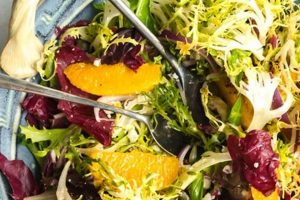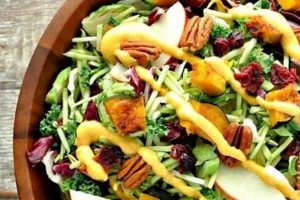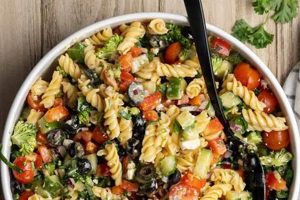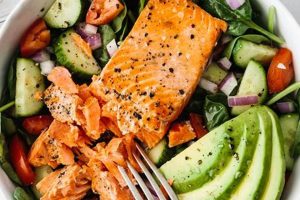A dish featuring cooked quinoa as its foundation, combined with various complementary ingredients, typically including vegetables, herbs, and a dressing. A straightforward preparation might involve cooked quinoa tossed with chopped cucumber, tomatoes, parsley, and a lemon vinaigrette. Such dishes offer a nutritious and customizable meal option.
Light yet satisfying, these meals provide a good source of protein and fiber, contributing to a balanced diet. Quinoa’s versatility allows for diverse flavor profiles and ingredient combinations, catering to a wide range of preferences and dietary needs. The increasing popularity reflects a growing awareness of whole grains and plant-based diets.
Further exploration will delve into specific ingredient selections, preparation methods, and variations to inspire culinary creativity and healthy eating habits.
Tips for Creating Delicious and Simple Quinoa Salads
Optimizing ingredient selection and preparation techniques elevates a simple quinoa salad from basic to exceptional. The following tips offer guidance for crafting flavorful and satisfying meals.
Tip 1: Rinse the quinoa. Rinsing removes the saponin coating, which can impart a bitter flavor. Place quinoa in a fine-mesh sieve and rinse under cold water until the water runs clear.
Tip 2: Toast the quinoa (optional). Toasting dry quinoa in a pan before cooking adds a nutty depth of flavor. Heat a dry pan over medium heat and toast the quinoa, stirring frequently, until fragrant.
Tip 3: Cook quinoa properly. Use a 2:1 ratio of water to quinoa. Bring the water to a boil, add the quinoa, reduce heat, cover, and simmer for 15-20 minutes, or until all the water is absorbed.
Tip 4: Fluff with a fork. Once cooked, fluff the quinoa with a fork to separate the grains and prevent sticking.
Tip 5: Incorporate diverse textures and flavors. Combine a variety of ingredients, such as crunchy vegetables (cucumber, bell peppers), soft vegetables (roasted sweet potatoes, avocado), fresh herbs (parsley, mint), and dried fruits or nuts for added complexity.
Tip 6: Dress strategically. A flavorful vinaigrette enhances the salad. Experiment with different combinations of oil, vinegar, and seasonings. Lemon juice, olive oil, and Dijon mustard create a classic vinaigrette.
Tip 7: Season thoughtfully. Salt and pepper are essential, but consider adding other spices like cumin, coriander, or chili flakes to complement the other ingredients.
Tip 8: Chill before serving (optional). Chilling allows the flavors to meld and enhances the refreshing qualities of the salad, particularly beneficial in warmer weather.
By following these tips, one can consistently create flavorful, nutritious, and satisfying quinoa salads suitable for various occasions.
These guidelines provide a solid foundation for crafting exceptional quinoa salads, setting the stage for endless culinary exploration.
1. Quinoa
Quinoa, a complete protein and ancient grain, serves as the foundational element in a simple quinoa salad. Understanding its characteristics is crucial for optimizing both the nutritional value and culinary potential of this dish. The following facets explore quinoa’s contribution to a successful simple quinoa salad recipe.
- Nutritional Profile
Quinoa provides all nine essential amino acids, making it a complete protein. It’s also a good source of fiber, iron, and magnesium. This nutritional density positions quinoa as a healthy base for a simple salad, contributing significantly to dietary requirements. For instance, the iron content contributes to healthy blood function, while the fiber aids digestion.
- Culinary Versatility
Quinoa’s mild, slightly nutty flavor profile makes it a versatile ingredient. It readily absorbs flavors from dressings and other components, allowing for diverse flavor combinations in salads. This adaptability allows for creations ranging from light and refreshing salads with citrus vinaigrettes to more robust salads with roasted vegetables and bolder dressings.
- Textural Contribution
Cooked quinoa offers a light and fluffy texture with a slight chewiness. This textural element adds a pleasant mouthfeel to salads, contrasting with the crispness of vegetables and the smoothness of dressings. This interplay of textures enhances the overall sensory experience.
- Preparation Considerations
Properly cooking quinoa is essential for achieving optimal texture and flavor in a salad. Rinsing before cooking removes saponins, which can cause bitterness. The correct water-to-quinoa ratio ensures fluffy, separate grains. These preparation steps directly impact the final quality of the salad. Overcooked quinoa can become mushy, while undercooked quinoa remains hard and unpleasant.
These facets underscore quinoa’s importance in a simple quinoa salad. Its nutritional value, culinary versatility, textural contribution, and ease of preparation establish it as an ideal base for a healthy and flavorful dish. Understanding these elements allows for informed ingredient selection and preparation techniques, elevating the simple quinoa salad to a satisfying and nutritious meal.
2. Vegetables
Vegetables play a crucial role in a simple quinoa salad, contributing significantly to nutritional value, flavor, texture, and visual appeal. Their inclusion elevates the dish from a simple grain-based meal to a vibrant and balanced culinary experience. The selection and preparation of vegetables directly impact the overall quality and character of the salad.
Nutrient-rich vegetables enhance the health benefits. Leafy greens like spinach or kale provide vitamins A and K. Cruciferous vegetables such as broccoli or cauliflower offer vitamin C and fiber. Colorful bell peppers contribute vitamin C and antioxidants. The inclusion of a variety of vegetables ensures a broader spectrum of nutrients, aligning with dietary recommendations for balanced intake. For example, a salad with roasted sweet potatoes offers beta-carotene, while adding chopped red onion provides quercetin, a flavonoid with antioxidant properties.
Beyond nutrition, vegetables enhance the sensory experience of a quinoa salad. Their varied textures and flavors create a dynamic interplay. Crisp cucumbers and bell peppers contrast with the soft chewiness of cooked quinoa. Roasted vegetables offer a caramelized sweetness, while raw vegetables provide a refreshing crunch. The strategic combination of different vegetables creates a multi-dimensional sensory profile. For example, combining raw cherry tomatoes with roasted zucchini creates a balance of sweetness and earthiness, while adding chopped fresh herbs like mint or parsley introduces bright, herbaceous notes.
Careful consideration of vegetable selection and preparation methods is essential for optimizing the final product. Raw vegetables offer crispness and brightness, while roasted vegetables provide a deeper, more complex flavor profile. Blanching or steaming vegetables can soften their texture while preserving nutrients. Understanding these techniques allows for precise control over the final outcome, tailoring the salad to specific preferences and dietary needs. This knowledge allows one to create a salad that is not only nutritious and flavorful but also visually appealing and texturally satisfying. The strategic combination of preparation techniques allows for a diverse range of textures and flavors within a single salad, enhancing the overall dining experience.
3. Herbs
Herbs constitute a vital element in simple quinoa salads, contributing significantly to the overall flavor profile, aroma, and visual appeal. Their judicious selection and application can elevate a basic quinoa salad to a sophisticated culinary creation. The following facets explore the multifaceted role of herbs in enhancing these salads.
- Flavor Enhancement
Fresh herbs impart distinct flavors that complement the mild taste of quinoa and other salad components. Bright, citrusy herbs like parsley and cilantro add a refreshing touch. Earthy herbs such as dill and oregano provide a savory depth. Mint offers a cooling element, while basil contributes a sweet, peppery note. The strategic use of herbs creates a complex flavor profile that balances and enhances the other ingredients. For instance, parsley pairs well with lemon vinaigrette, while mint complements cucumber and feta cheese.
- Aromatic Complexity
Beyond flavor, herbs contribute to the overall aromatic experience of a quinoa salad. The volatile oils released by fresh herbs create a fragrant bouquet that enhances the sensory appeal. The aroma of chopped dill, for instance, can stimulate appetite and create anticipation for the flavors to come. The interplay of aromas from different herbs adds another layer of complexity to the dish. A combination of parsley, mint, and oregano can create a vibrant and inviting aroma.
- Visual Appeal
The vibrant green hues of fresh herbs enhance the visual presentation of a quinoa salad. Sprinkling chopped herbs over the salad adds a pop of color, making the dish more visually appealing. The variety of shapes and textures of different herbs further contributes to visual interest. The delicate fronds of dill contrast with the broad leaves of basil, adding textural variety alongside visual appeal. This visual enhancement elevates the dining experience.
- Nutritional Benefits
Many herbs offer potential health benefits in addition to their culinary contributions. Parsley is a good source of vitamins K and C. Mint can aid digestion. Oregano possesses antioxidant properties. Incorporating herbs into a quinoa salad not only enhances the flavor and appearance but also adds nutritional value. While the quantities of herbs used in salads might not provide substantial amounts of specific nutrients, their inclusion contributes to a more holistic and health-conscious approach to meal preparation.
The strategic incorporation of herbs is integral to crafting a successful simple quinoa salad. Their ability to enhance flavor, aroma, visual appeal, and nutritional value elevates the dish beyond its basic components. Understanding the unique characteristics of different herbs allows for informed choices, resulting in a balanced and satisfying culinary experience. A carefully crafted combination of herbs transforms a simple quinoa salad into a flavorful, aromatic, visually appealing, and nutritious meal.
4. Dressing
Dressing constitutes a critical component in simple quinoa salads, significantly influencing the final flavor profile, texture, and overall enjoyment. It acts as a unifying element, binding individual ingredients into a cohesive whole. The choice of dressing profoundly impacts the sensory experience, transforming a basic quinoa salad into a flavorful and satisfying meal. The relationship between dressing and simple quinoa salad recipes hinges on several key factors.
Flavor balance represents a primary consideration. The dressing should complement the inherent flavors of the quinoa and other ingredients without overpowering them. A light and tangy vinaigrette, for example, enhances the nutty flavor of quinoa and the freshness of vegetables without masking their individual characteristics. Conversely, a creamy dressing based on tahini or yogurt might provide a richer, more substantial counterpoint to roasted vegetables and bolder spices. Specific examples include a lemon-herb vinaigrette for a Mediterranean-style salad, a ginger-soy dressing for an Asian-inspired salad, or a creamy avocado dressing for a salad featuring roasted sweet potatoes and black beans. The interplay between the dressing and other ingredients creates a harmonious flavor profile.
Texture also plays a crucial role. The dressing contributes to the overall mouthfeel of the salad. A vinaigrette adds a light and refreshing element, while a creamy dressing imparts a richer, more substantial texture. The consistency of the dressing also affects how it coats the other ingredients. A thinner dressing lightly coats the quinoa and vegetables, allowing their individual textures to shine through. A thicker dressing adheres more substantially, creating a more cohesive and creamy texture throughout the salad. Understanding this interplay allows for the creation of salads with diverse textural experiences, ranging from light and refreshing to rich and decadent.
Finally, dressing contributes to the overall moisture content and perceived freshness of the salad. It prevents the quinoa and vegetables from drying out, maintaining a pleasant texture and enhancing palatability. The acidity in some dressings, such as vinaigrettes, also acts as a preservative, extending the shelf life of the salad. This practical consideration is particularly relevant for meal prepping or preparing salads in advance. The choice of dressing, therefore, affects not only the immediate sensory experience but also the longevity and practicality of the salad. Mastering the art of dressing selection and preparation is fundamental to creating successful simple quinoa salads, transforming a basic dish into a culinary delight.
5. Protein (optional)
Supplemental protein enhances simple quinoa salads, transforming them into more substantial and nutritionally complete meals. While quinoa itself offers complete protein, incorporating additional sources broadens the amino acid profile and elevates the overall protein content. This addition caters to individuals with higher protein requirements, such as athletes or those following specific dietary regimens. The impact of added protein extends beyond nutritional value, influencing texture, flavor, and satiety. Adding grilled chicken or fish, for example, introduces a savory element and a denser texture, complementing the light and fluffy quinoa. Chickpeas or lentils contribute a nutty flavor and a slightly firmer texture, enhancing the salad’s heartiness. These additions extend beyond mere supplementation, actively contributing to the overall sensory experience.
The choice of supplemental protein should align with the overall flavor profile of the salad. Grilled chicken or tofu pairs well with Asian-inspired dressings, while chickpeas or lentils complement Mediterranean flavors. Hard-boiled eggs provide a neutral protein source that readily adapts to various flavor combinations. Consideration should also be given to textural compatibility. Crunchy nuts or seeds contrast with the soft texture of quinoa, while flaked fish adds a delicate flakiness. The interplay of textures creates a more dynamic and satisfying culinary experience. Practical considerations also influence protein selection. Pre-cooked or easily prepared options, such as canned beans or leftover roasted chicken, streamline the salad assembly process, enhancing the convenience factor for busy individuals. Understanding these factors allows for strategic protein choices that elevate both the nutritional value and culinary appeal of simple quinoa salads.
Strategic protein inclusion elevates simple quinoa salads from side dishes to complete meals, increasing satiety and nutritional value. Careful consideration of flavor profiles, textures, and practicalities ensures the chosen protein harmonizes with the other salad components, resulting in a balanced and satisfying culinary experience. This understanding transforms the “optional” protein addition into a valuable tool for creating customizable and nutritionally optimized meals. It addresses the limitations of relying solely on quinoa for protein, catering to a broader range of dietary needs and preferences while enhancing the overall dining experience.
6. Preparation method
Preparation methods significantly influence the final quality and character of simple quinoa salads. Distinct approaches yield varied outcomes in terms of texture, flavor integration, and overall presentation. Consideration of the preparation method is essential for achieving desired results, transforming a basic recipe into a tailored culinary experience. The connection between preparation method and simple quinoa salads lies in the cause-and-effect relationship between technique and outcome.
Different techniques affect ingredient interaction and final presentation. Combining cooked, cooled quinoa with raw vegetables and a vinaigrette creates a light and refreshing salad with distinct textures. Roasting vegetables before incorporating them into the salad introduces caramelized flavors and softer textures. Toasting quinoa prior to cooking adds a nutty depth and enhances its ability to absorb flavors from the dressing. Layering ingredients, rather than simply tossing them together, allows for a more deliberate presentation and distinct flavor experiences with each bite. For example, layering roasted sweet potatoes, black beans, corn, avocado, and a cilantro-lime dressing creates a visually appealing and texturally diverse salad. Alternatively, tossing cooked quinoa with chopped cucumbers, tomatoes, feta cheese, and a lemon-herb vinaigrette produces a lighter, more refreshing option. Each method yields a unique result, highlighting the importance of preparation as a defining characteristic of the final dish.
Understanding the impact of various preparation methods empowers informed choices, aligning technique with desired outcomes. This knowledge allows for customization based on personal preferences, dietary needs, and available ingredients. Whether seeking a light and refreshing salad or a more substantial and complex meal, the preparation method serves as a crucial tool for achieving culinary goals. Mastery of these techniques elevates the simple quinoa salad from a basic dish to a versatile and adaptable culinary creation, reflecting the direct link between preparation and outcome.
Frequently Asked Questions
This section addresses common inquiries regarding simple quinoa salad recipes, offering practical guidance for optimal preparation and enjoyment.
Question 1: How can bitterness in quinoa be avoided?
Rinsing quinoa thoroughly under cold water before cooking removes saponins, the naturally occurring compounds responsible for potential bitterness.
Question 2: What is the ideal water-to-quinoa ratio for cooking?
A 2:1 ratio of water to quinoa generally yields optimal results, producing fluffy and separate grains.
Question 3: Can quinoa salads be prepared in advance?
Yes, quinoa salads can be prepared ahead of time and stored in the refrigerator. Dressing should be added just before serving to prevent the salad from becoming soggy.
Question 4: How can the nutritional value of a quinoa salad be maximized?
Incorporating a variety of colorful vegetables, lean protein sources, and healthy fats maximizes the nutritional density of the salad.
Question 5: What are suitable dressings for simple quinoa salads?
Versatile options range from light vinaigrettes to creamy dressings based on yogurt, tahini, or avocado. The chosen dressing should complement the other ingredients.
Question 6: How can leftover cooked quinoa be utilized in a salad?
Leftover quinoa can be incorporated directly into a salad. Ensure it is cooled completely before combining it with other ingredients.
Understanding these fundamental aspects ensures consistent success in preparing flavorful and satisfying simple quinoa salads.
The following sections will provide specific recipe examples and variations, further expanding culinary possibilities.
Simple Quinoa Salad Recipes
Exploration of simple quinoa salad recipes reveals a dish offering nutritional value and culinary versatility. From the foundational grain to the diverse array of complementary ingredients, each component contributes to the final product. Proper preparation techniques, including rinsing the quinoa and selecting appropriate vegetables, herbs, and dressings, ensure optimal flavor and texture. Supplemental protein and considered preparation methods further enhance the dish, transforming it from a simple side to a complete and satisfying meal. Understanding these elements empowers culinary creativity and facilitates the creation of personalized variations.
The adaptability of simple quinoa salad recipes positions them as a valuable addition to any culinary repertoire. Continued exploration of flavor combinations and ingredient pairings offers endless possibilities for creating nutritious, flavorful, and visually appealing meals. This culinary canvas invites experimentation and innovation, promising a rewarding journey for both novice cooks and experienced chefs alike. The potential for customization ensures that simple quinoa salad recipes remain a relevant and adaptable culinary choice, reflecting evolving dietary preferences and culinary trends.






